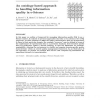18 search results - page 2 / 4 » Specifying Properties of Concurrent Computations in CLF |
CONCURRENCY
2008
13 years 5 months ago
2008
context. In contrast to previous approaches that take a very abstract view of IQ properties, we allow scientists to define the quality characteristics that are of importance to the...
STOC
2005
ACM
14 years 6 months ago
2005
ACM
In the setting of secure multiparty computation, a set of parties wish to to jointly compute some function of their input (i.e., they wish to securely carry out some distributed t...
ESOP
2004
Springer
13 years 11 months ago
2004
Springer
A transaction defines a locus of computation that satisfies important concurrency and failure properties; these so-called ACID properties provide strong serialization guarantees ...
PPOPP
2012
ACM
12 years 1 months ago
2012
ACM
The actor model has already proven itself as an interesting concurrency model that avoids issues such as deadlocks and race conditions by construction, and thus facilitates concur...
CHARME
2001
Springer
13 years 9 months ago
2001
Springer
Model checking is the process of verifying whether a model of a concurrent system satisfies a specified temporal property. Symbolic algorithms based on Binary Decision Diagrams (BD...

